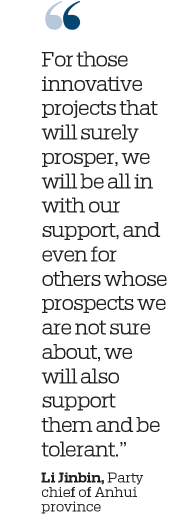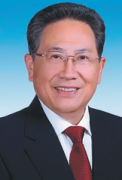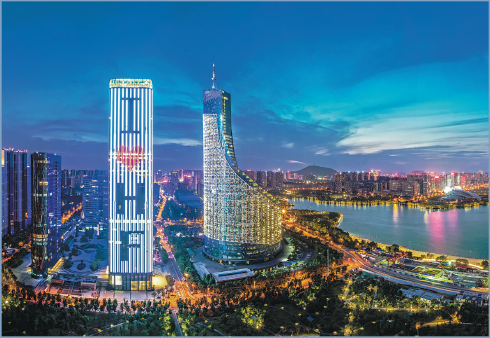Anhui's essentials: Innovation, industry

Once dominated by agriculture sector, eastern province has turned its attention to high-end manufacturing
Editor's note: This year, the Communist Party of China is celebrating the 100th anniversary of its founding. China Daily is publishing a series of stories looking at the tremendous changes that have occurred in provinces, autonomous regions and municipalities under the leadership of the Party. They also include stories of the people and places that have left indelible marks in the Party's path to glory.
"A bird may go unnoticed if it doesn't sing for 10 years, but once it sings, it will sing high and amaze the world," said Li Jinbin, Party chief of Anhui province, referring to an old Chinese idiom.
Li, who is secretary of the CPC Anhui Committee, made the remark while delivering his speech to officials and entrepreneurs from across the country during the 2020 China (Anhui) Transformation Fair of Scientific and Technological Innovation Achievements, which concluded in the provincial capital of Hefei on April 27.
"For those innovative projects that will surely prosper, we will be all in with our support, and even for others whose prospects we are not sure about, we will also support them and be tolerant," Li said.
Before 1978, farmers from Fenyang county in the inland province were known for singing songs begging for food while traveling around China.
At that time, China's collectivized farming policy was in force. The policy disallowed individual farms and made farmers combine their lands to grow crops for all.
In December that year, after the policy had been in effect nationwide for about 20 years, 18 farmers in the county's Xiaogang village secretly signed an agreement to subdivide their common farmland into family plots in hopes of increasing crop yields.
The people of Xiaogang then became the first in the country to escape famine, setting a milestone for China's rural reform.
In 1978, Anhui's annual GDP was 11.4 billion yuan ($1.77 billion). Last year, it reached 3.87 trillion yuan, according to the provincial government's data.
Manufacturing a future
At a news conference held by the State Council Information Office for the province in 2019, Li said Anhui had finished a historic transformation from an agriculture-dominant province to an emergent power of industry.
Yaohai district, in northeast Hefei, is home to a 30-square-kilometer area of old factory plants that is transforming into a base for art venues and leisure grounds.
As people contemplate the glorious history of a preserved furnace of a steel company built in the 1950s, modern buildings and large mansions are rising on a brand-new 34-sq-km eastern subcenter of the city, like bamboo shoots after a spring rain.
To the west of the city's urban area, the 1,130-hectare Hefei Xinqiao Intelligent Electric Vehicle Industrial Park broke ground for construction on April 29, with an initial investment of 50 billion yuan.
In November, the Hefei municipal government pledged to increase the city's new-energy vehicle industry annual output value to 100 billion yuan by 2025.
The new park is more ambitious, aiming to raise the output value to 500 billion yuan in the few years after 2025.
Automotive industry
The investors include Nio, a major electric car startup who has its domestic headquarters in Hefei and its global headquarters in Shanghai. By April, more than 100,000 Nio vehicles had rolled off its Hefei production line.
During an interview last year, Li Bin, founder and CEO of Nio, said the company has been manufacturing in Hefei since the company was founded in 2014, and the team in Hefei has grown rapidly, laying a solid foundation for the company's growth.
Volkswagen is also making its mark in the city.
"Hefei will be Volkswagen's main production base for electric vehicles in China," said Joerg Mull, chief finance officer of Volkswagen Anhui, a joint venture of Volkswagen AG and Hefei-based JAC Motors.
Other major automakers include Chery, the largest Chinese auto brand, which is based in Wuhu city and sees annual sales revenues of more than 100 billion yuan.
Year-on-year, production of NEVs in Anhui soared to 39,000 units in the first quarter of this year, according to the provincial Department of Economy and Information Technology.
With auto manufacturing as a pillar industry, Anhui has nearly 1,000 major companies-those with an annual turnover of at least 20 million yuan-engaged in the auto industry, according to the department.
The authorities said the whole industrial chain for the auto manufacturing industry has been well formed.
Near Nio's plant in the Hefei Economic and Technological Development Area is the LCFC company, Lenovo's largest PC manufacturing base in China which has been the province's largest exporter for seven consecutive years.
The company, whose annual sales revenue surpassed 100 billion last year, receives more than 60 percent of the parts from over 70 suppliers from the province, according to Bai Peng, CEO of LCFC.
In the development zone also lies Chang-Xin Memory Technologies, one of the earliest integrated circuit companies to invest in Hefei in 2016. In May last year, the company entered a new phase with an investment of 33.3 billion yuan and broke ground for construction in the zone.
The company specializes in dynamic random access memory chips and will amass a total investment of 220 billion yuan.
Now the city is enjoying an intact chain for integrated circuit development and related companies, including those engaged in original material production, chip designing, manufacturing and package testing.
Other major high-tech companies in Hefei include BOE Technology, a leading Chinese supplier of display products and solutions.
By last year, the number of high-tech enterprises in the province had increased to 8,559 from 1,742 of 2012. The average ownership of invention patents in the province has also reached 15.4 patents per 10,000 people, compared to 1.3 in 2012, according to the Anhui provincial government.
The province has especially stood out for its efforts in developing the chip industry as the country endeavors to be self-reliant on key technologies and lessen its dependence on microprocessors from overseas, according to provincial authorities.
zhulixin@chinadaily.com.cn

























